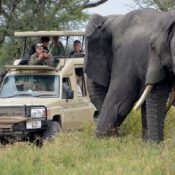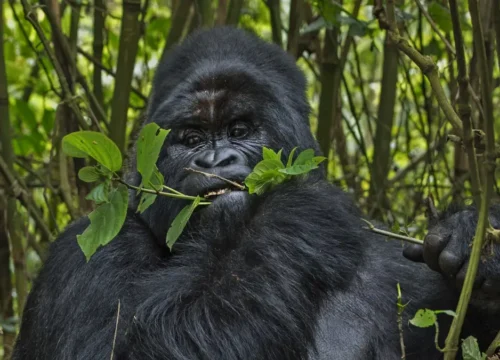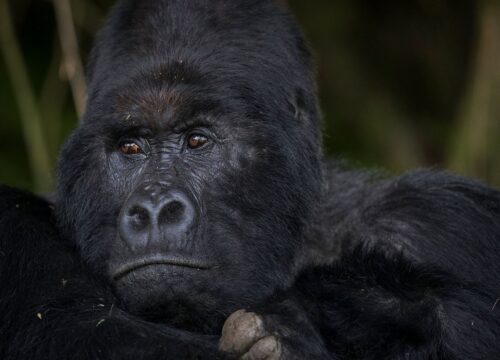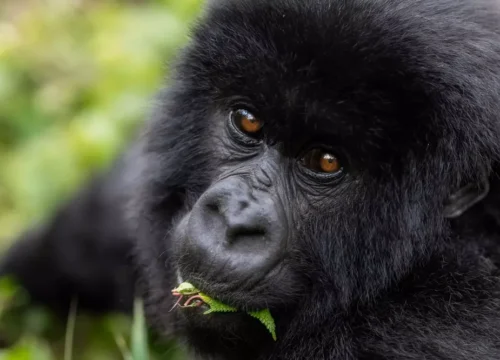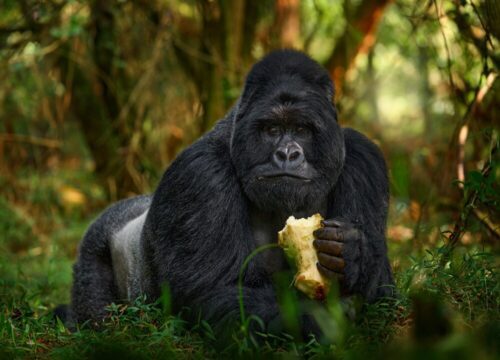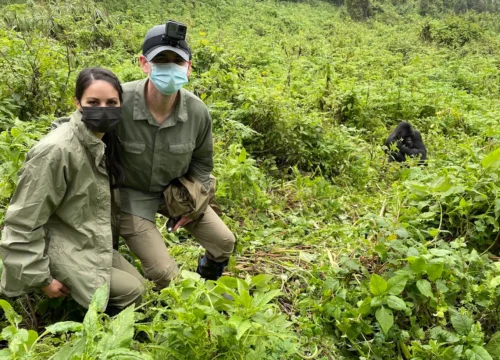Kruger National Park
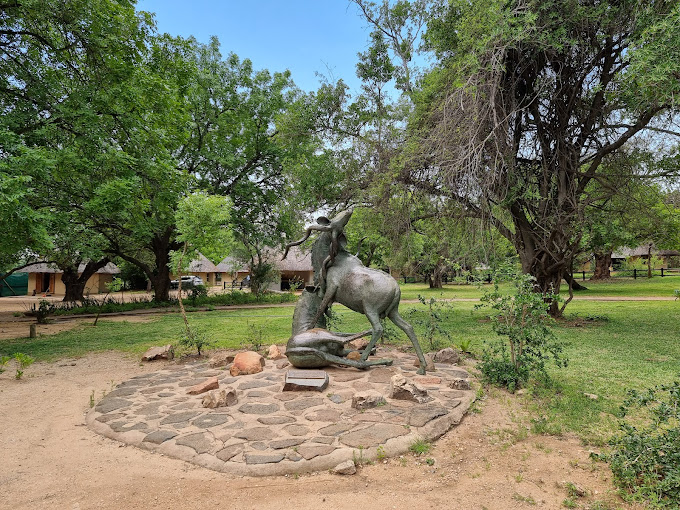

Kruger National Park Overview
Kruger National Park is justifiably one of the most famous parks in Africa. The park is the size of a small country and supports a huge variety of wildlife. All of the Big Five are present in large numbers. A comprehensive road network that is fine for 2WD cars means Kruger is one of the best parks for self-drive safaris.
Wildlife & Animals In Kruger National Park

Kruger Park has an amazing variety of wildlife with all big safari animals present. All the big cats are found and lion, in particular, are frequently seen in the south of the park. White rhino are under threat from a dramatic increase in poaching in recent years, but you still have a reasonable chance of spotting one. Buffalo and elephant are easily seen throughout.
Wildlife Highlights
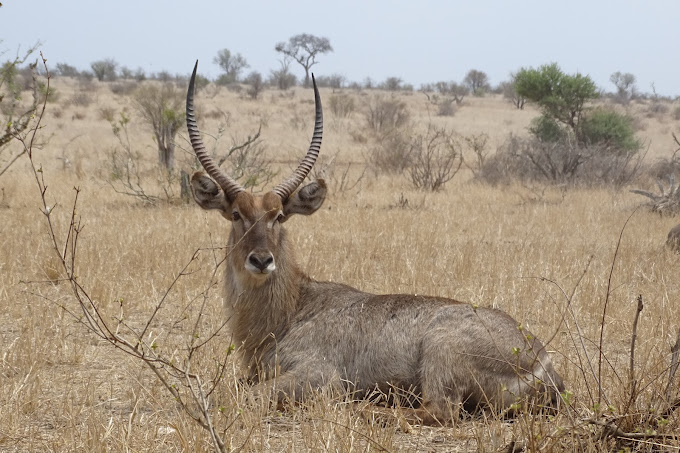
Graceful antelope are a highlight of Kruger. Impala, greater kudu and waterbuck are common. Two secretive species to look out for are steenbok and common duiker. The endangered wild dog lives in large groups that range far and wide, although it is rarely spotted. Cheetah is most likely seen in the open grassland areas of central Kruger.
Best Time for Wildlife Viewing
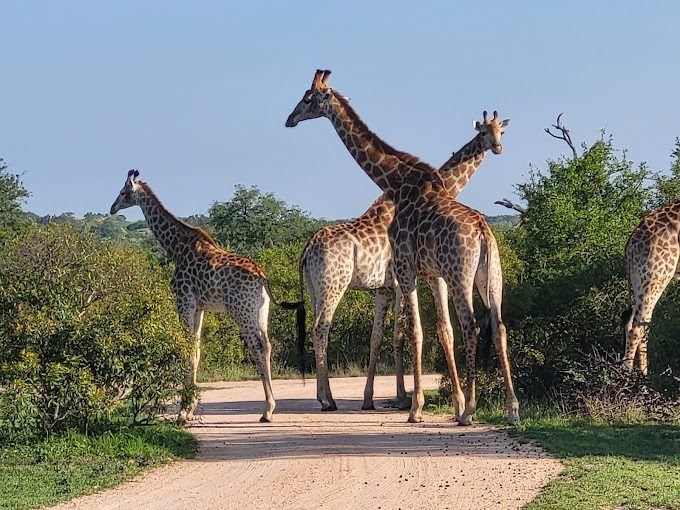
The best time for wildlife viewing in Kruger Park is during the dry months of June to September when the vegetation is less thick. August to September is a recommended time as temperatures are higher than in mid-winter and the animals are concentrated around water sources making for excellent wildlife watching.
Birds
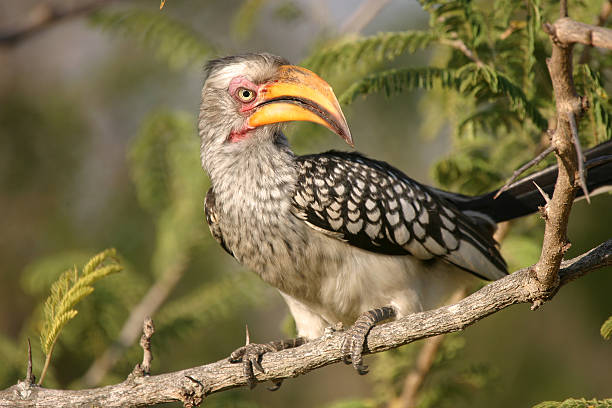
More than 500 bird species have been recorded in Kruger, representing roughly 60 percent of the total for South Africa. This includes more than 50 migratory species, most of which arrive from Eurasia or elsewhere in Africa in November and depart in April. Kruger is the best place in the country to see birds of prey; around 55 diurnal and 11 nocturnal species have been recorded. The less visited northern part of the park offers the best bird watching. All the rest camps tend to be hot spots because there is a high concentration of trees and shrubs.
Birding Specials–Treats for Avid Birders
- African finfoot
- Bearded scrub robin
- Brown-headed parrot
- Greater blue-eared starling
- Kori bustard
- Lappet-faced vulture
- Martial eagle
- Pel’s fishing-owl
- Saddle-billed stork
- Senegal lapwing
- Southern ground hornbill
- Tawny eagle
- Thick-billed cuckoo
- Thrush nightingale
- White-headed vulture
- Yellow-billed oxpecker
Best Time for Bird Watching
Bird watching in Kruger Park is good year-round, but at its best from November to April, when Eurasian and intra-African migrants are present. The best time for general wildlife viewing is during the dry months of June to September.
Best Time To Visit Kruger National Park
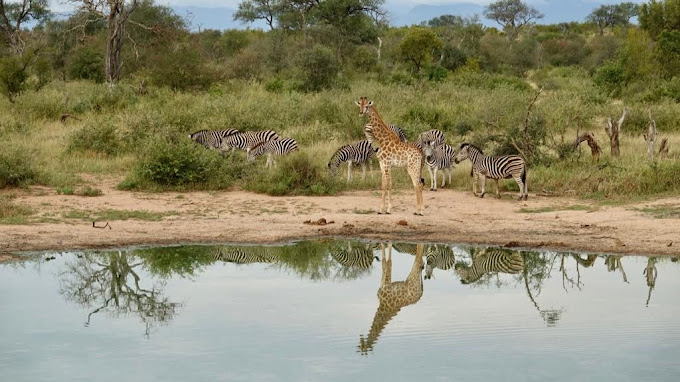
The best time to visit Kruger National Park is during the dry winter months from May to September. At this time, the bush thins out, and animals congregate around waterholes and rivers. Conditions tend to get better as winter progresses, and September is particularly lovely since the mornings are less chilly than in mid-winter. The best wildlife viewing time also coincides with the low season, making it even more attractive.
Best Time: May to September (Dry season)
High Season: December to January and July to August (Especially during school holidays)
Low Season: April to mid-June and September to November (Except for the October school holiday)
Best Weather: April to May and September to October (Mild weather and little rain)
Worst Weather: June to August (Chilly mornings and nights) and December to February (Hot and humid)
May to September –Dry Season – Winter
- Wildlife gathers around water and vegetation thins out making viewing much easier
- It is low season, except for the school holidays, and the camps and roads are less busy
- Sunny skies and no rain
- Mild daytime temperatures and low humidity
- Virtually no risk of malaria
- It is very dry and dirt roads become dusty
- Early morning game drives in open vehicles are cold; warm clothing is required
October to April –Wet Season – Summer
- The scenery is green and fresh
- There are many baby animals, and wildlife is in good condition
- Birding is excellent, and the migratory birds are present
- Wildlife viewing is not as good as during the Dry season
- It is high season, and the main camps get busy
- Hot and humid in the middle of the day
- It is advisable to take antimalarial medication
Weather & Climate Kruger National Park
Kruger National Park experiences winter and summer at the opposite times to Europe and North America. The wet summer months (October to April) are hot and often humid. Dry winters (May to September) are warm and mild although it cools off considerably at night. It is advisable to take warm clothing for early morning and evening game drives.
Dry Season–May to September – Winter
There is virtually no rainfall during the whole of winter, and the humidity is very low. Animals are attracted to permanent water sources as water becomes scarce in the bush.
- May – This is a transitional month and marks the end of summer. Temperatures are cooling down to an average of 12°C/54°F in the morning and 28°C/82°F in the afternoon.
- June, July & August – Morning game drives in open vehicles will be cold, so pack warm clothing. The average morning temperature is 11°C/52°F. Afternoons will be pleasant with temperatures around 25°C/77°F and cloudless skies.
- September – The heat gradually builds to about 28°C/82°F in the afternoon, and the first rains bring relief from very dry conditions. Mornings are less cold with temperatures around 15°C/59°F.
Wet Season–October to April – Summer
It can be uncomfortably hot and humid in summer. Peak temperatures frequently reach well over 40°C/104°F, although average daytime temperatures are 32°C/90°F with high humidity. It seldom rains all day, but the pattern is afternoon storms.
- October & November – It gets warmer and starts to rain more often, mostly in the afternoon. Temperatures are between 18°C/64°F in the morning and 31°C/88°F in the afternoon.
- December, January & February – These are the wettest and hottest months, characterized by torrential downpours in the afternoon and high humidity. Afternoon temperatures are usually around 32°C/90°F but can soar up to an unbearable 40°C/104°F.
- March & April – Rainfall decreases, and it slowly gets colder. April has lovely, clear weather and few clouds. The nights get a bit chillier but are still pleasant at about 16°C/61°F. Daytime temperatures are around 32°C/90°F and the humidity drops.
Getting There

Most visitors to Kruger National Park fly into O.R. Tambo International Airport (JNB), near Johannesburg. It is also possible to fly directly from Germany to Kruger Mpumalanga International Airport (MQP), 40km/25mi from southern Kruger’s Numbi Gate.
Kruger is a popular self-drive destination. You can hire a car in O.R. Tambo International Airport (JNB) and drive straight to the park. Kruger has nine entrance gates, the closest of which is Numbi Gate, 375km/235mi from the airport. The drive to Numbi Gate takes 4 to 5 hours*.
Airlines & Ticket Prices
Please check Skyscanner to see which airlines can take you to O.R. Tambo International Airport (JNB), and what tickets would cost.
Domestic Flights
On arrival at O.R. Tambo International Airport (JNB), near Johannesburg, you can take a connecting flight to Kruger Mpumalanga International Airport (MQP). Alternatively, you can fly to Hoedspruit (for central and northern Kruger) or Phalaborwa (for northern Kruger).
It is also possible to take a scheduled flight to Skukuza Airport (SZK) inside the park, and Federal Airlines offers scheduled flights to some of the lodges’ airstrips. Charter flights to Skukuza or any of the lodges’ airstrips are also available.
Scheduled domestic flights can be booked with several carriers:
- SA Airlink (Flies to Skukuza, Mbombela, Hoedspruit and Phalaborwa)
- CemAir (Flies to Hoedspruit)
- FlySafair (Flies to Hoedspruit)
- Federal Airlines (Flies to some lodges within Kruger)
Want To Visit Kgalagadi TP?
INQUIRE NOW
GENERAL INFORMATION ON A SOUTH AFRICA SAFARI
ENTRY REQUIREMENTS:
All visitors to South Africa must have a valid passport with at least 4 consecutive blanks pages. Any applicable visa and/or relevant documentation are the responsibility of the traveller. For further information on Visa requirements visitors are advised to contact their nearest South African Embassy or Consulate.
LANGUAGE:English
TIME: GMT +3
VOLTAGE: 220 Volts/AC50Hz. Sockets are UK style, 3 pin square plugs. Power is from the government in the city/major towns and generator with inverter back up in the Safari Lodges and Camps.
CURRENCY: Foreign currency must be changed at the Bank, Bureau de Change, and Hotel/Safari lodge/Camp/Resort. Major Credit Cards, Master card, Visa, American Express, are usually accepted throughout the country. Where credit cards are accepted, the payment will normally be recorded in US$ regardless of the card’s default currency.
CLOTHING: Dress is mainly informal and should be comfortable as well as practical. Something warm should be brought along for early morning and evenings. Safari clothes are available from hotels/lodges/camps.
BAGGAGE: Where possible, travel light. Baggage space on safari is limited to medium suitcase or soft bag per person plus reasonable amount of hand luggage. There is 15 Kilogram per person limit on all flights to the wildlife sanctuaries. Excess luggage must be stored in your arrival hotel.
WATER: You will find many different of opinion of what is safe and what is not. We recommend for peace of mind, to drink local Bottled Mineral water. It is important to drink plenty of water especially during the hotter months. We would recommend that guests drink at least 2 to 3 liters of water per day to limit the effects of dehydration.
HEALTH; East Africa is a safe and secure destination; however, it is a good idea to take a few precautions. Kindly consult your GP or local doctor at least 6 weeks before you travel, with regards: Malaria prophylactics. East Africa is a known malaria area and preventive measures are essential. You are advised to take one of the recommended anti-malarial drugs. Be sure to wear long sleeved shorts and trousers after sunset and spray the exposed parts of your body with a mosquito repellent spray Remember to protect yourself from direct sun rays with sunscreen cream or safari hat.
DIETARY REQUIREMENTS: For those guests with specific dietary requirement, please ensure we are notified prior to travel
GRATUITIES: As a guideline and dependent on how happy you are, we would suggest the following: The General Hotel/Lodge/Camp Staff – Approximately U$ 10.00 per person per day Driver Guides – Approximately US$ 15.00 to US$ 20.00 per person per day.
PHOTOGRAPHY: Please be careful when photographing public buildings, airports, bridges, the national flag and people in uniform. Ensure that you have sought permission before photographing local people and their villages. If in doubt, please check with your guide.
Book a Customized Safari
Read about
10 Things you Should NOT DO on an African Safari.
What to expect on a safari in Uganda.
Bwindi Impenetrable National Park
How to Choose the Best Tour Operate for Your Safari in Africa
12-Day Gorilla Tracking in Bwindi
Some of our Gorilla and wildlife Safaris
1 Day Jinja Ultimate tour Experience
1 Day White Water Rafting in Jinja
3 Days Bwindi Gorilla Habituation via Rwanda
3 Day Birding Safaris and Photography in Uganda
3 Day Safari to Queen Elizabeth National Park
3 Day fly in Gorilla Trekking Safari from Masai Mara
3 Day Grand Gorilla Trekking Safari
4 Day Chimpanzee and Gorilla Trekking Safari
Recent Posts
Last Minute Deals
Quick booking process
+49 1575 4711313



